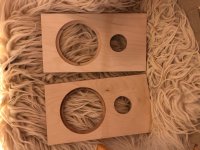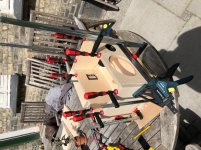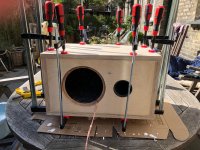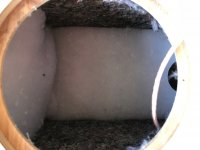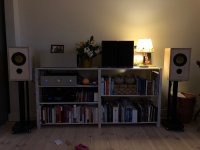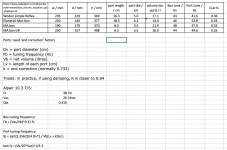Edit: Sorry about the image rotation, not sure what went wrong there..
Just wanted to say thanks to Scott for this design. I recently built a foamcore MarKen for a pair of enabled 10ps i got from Dave. It was a fun project and a nice sounding box, but compared to my other speakers i felt like they didnt quite fill the room with sound the way i liked. Either not enough bracing or i got something wrong in the tuning when converting the dimensions to fit the foamcore thickness.
Either way, I decided to build these bass reflex standmounts to let me enjoy the drivers while waiting for time to build pensils or frugal horns. I got the panels cut for a reasonable price in some nice 18mm BB ply. First mistake i realized was i didnt get a spare front panel to let me muck around with the router. This is only my second wooden box (the first was a tabaq), but i got away unscathed with a very nice fit by taking it very slowly and measuring 5 times before routing 🙂
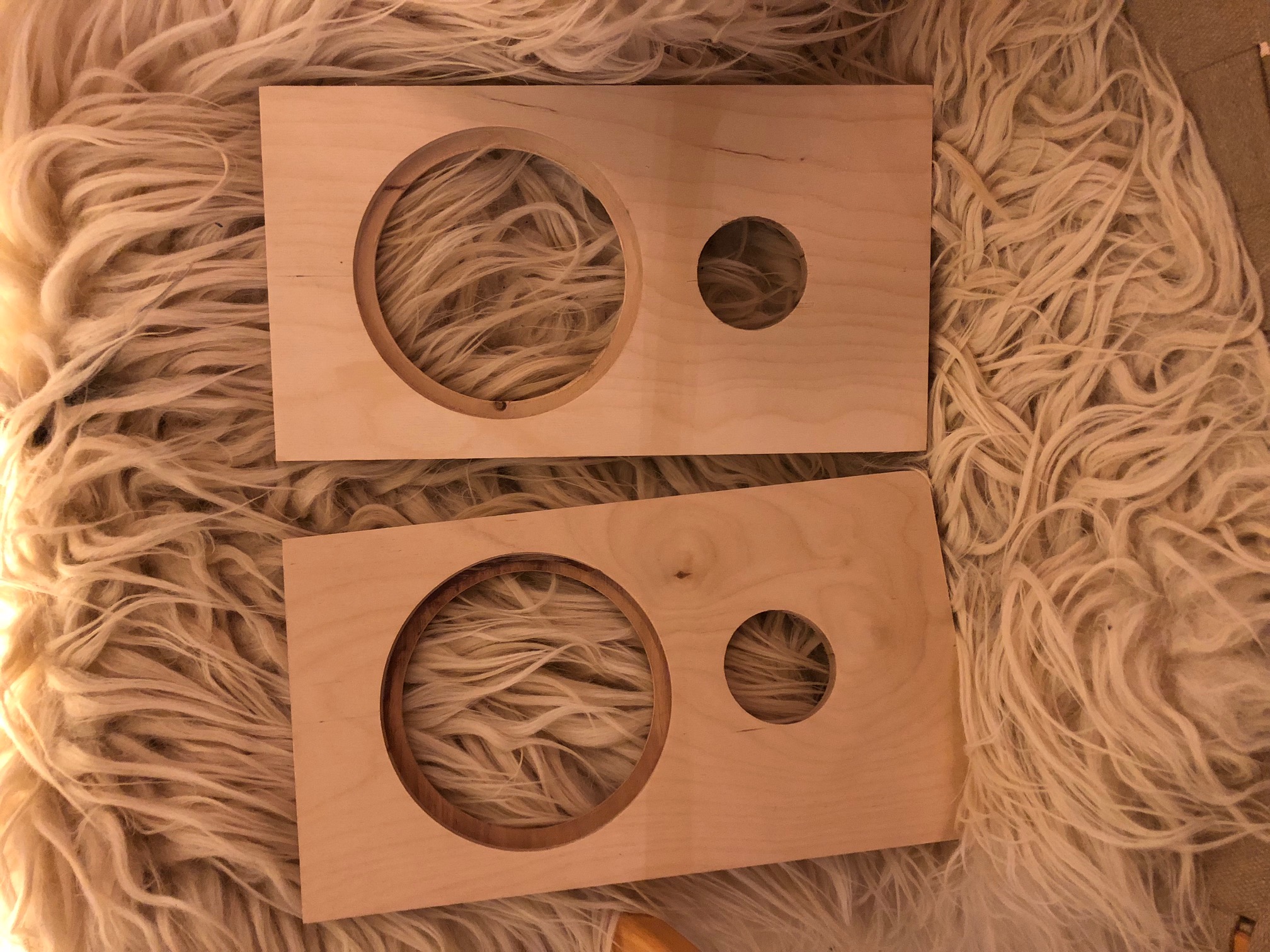
Today we had glorious spring weather so i spent the day in the garden gluing up the cabs.
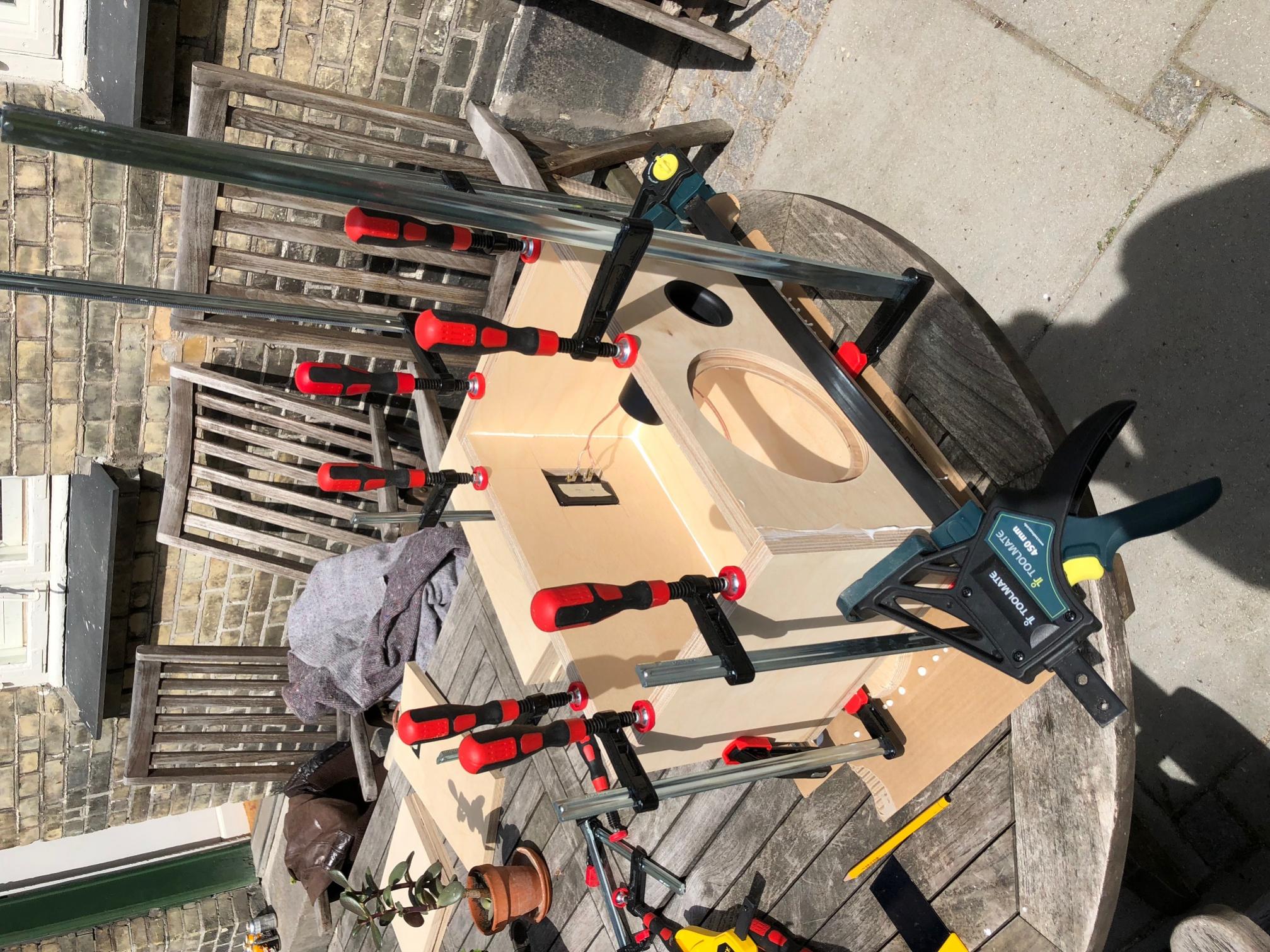
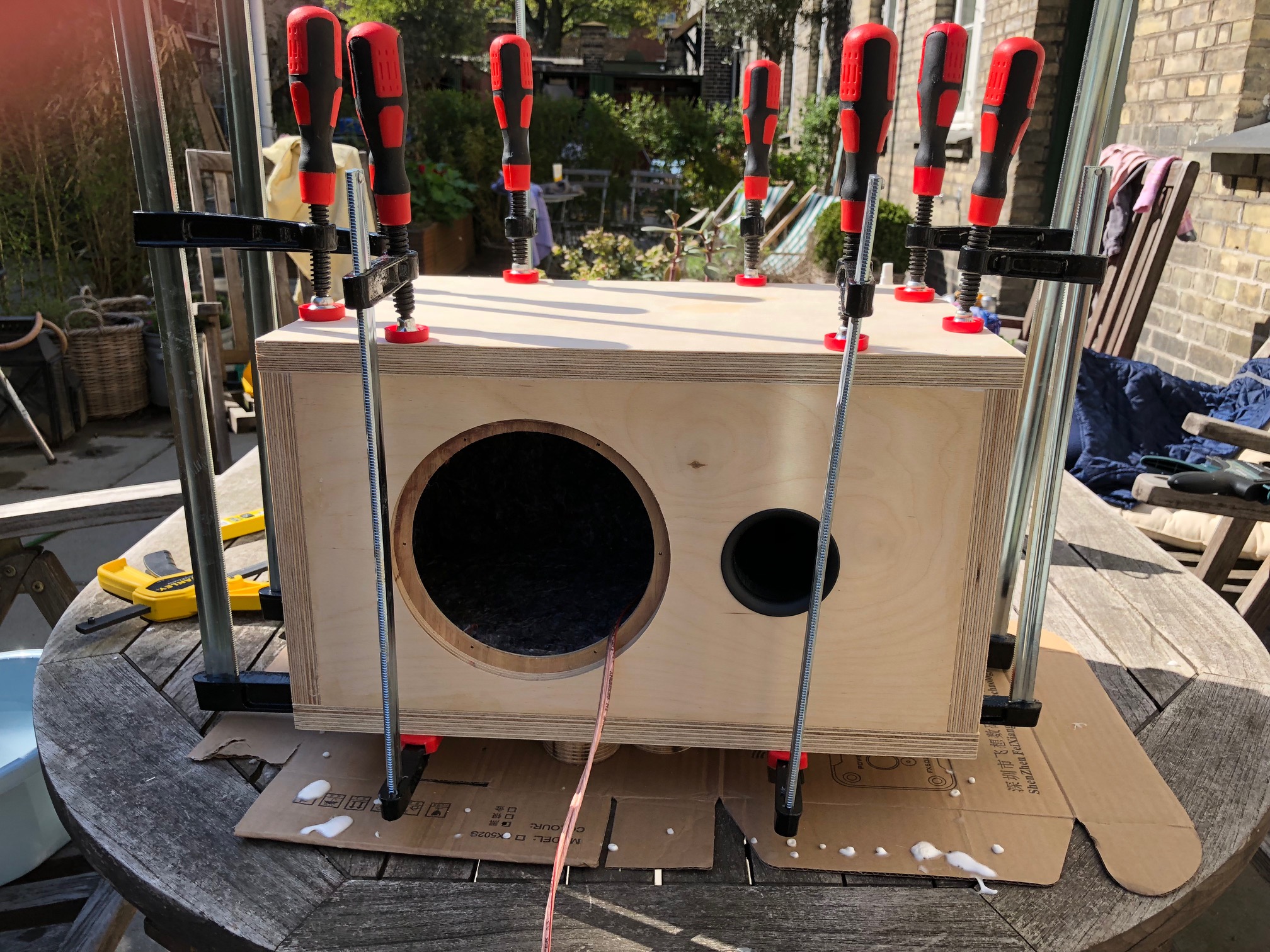
I lined all internal surfaces with 10mm felt and added some monacor mm-4 in the bottom, along the back and top.
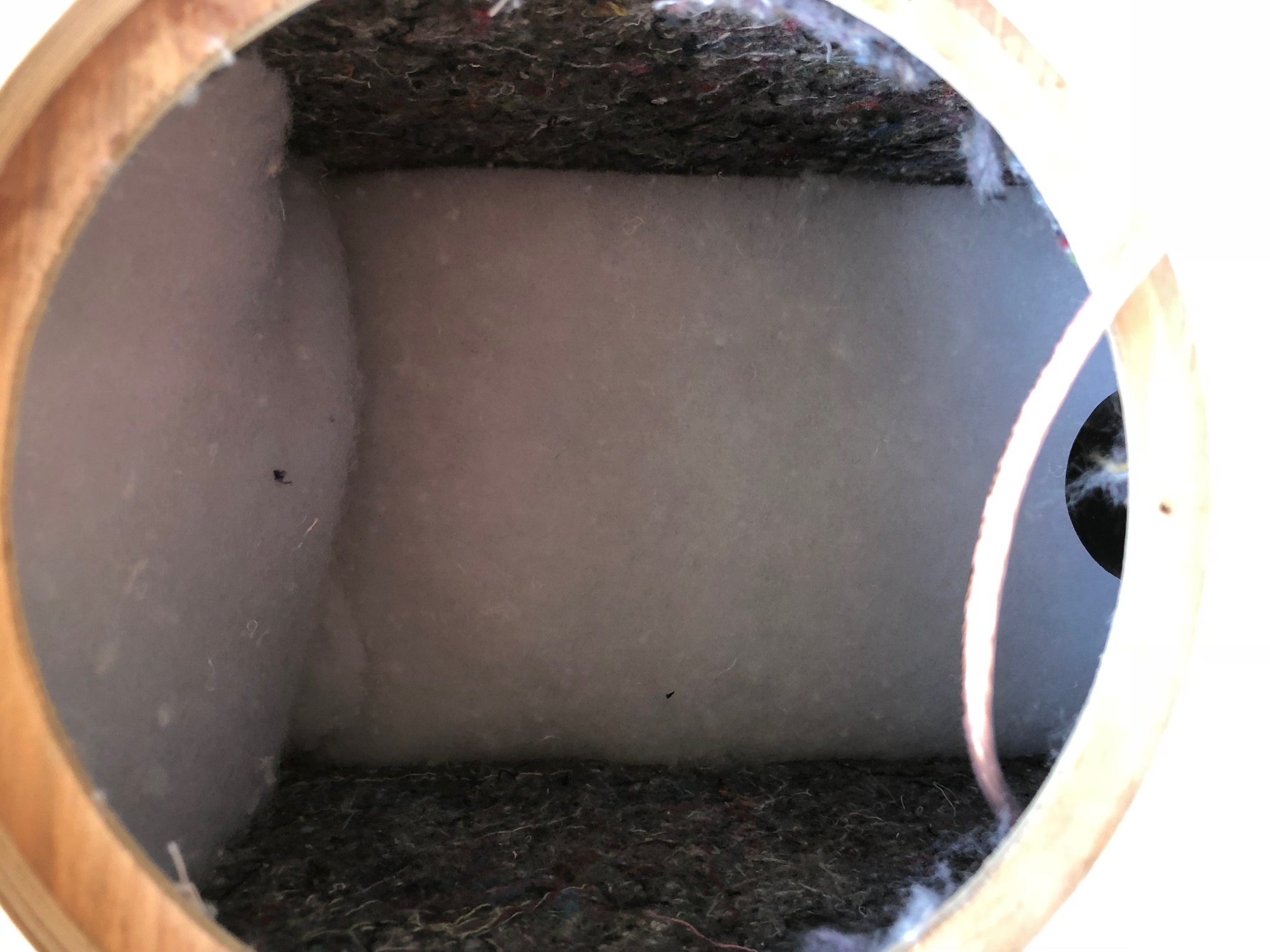
They are now in my living room and im listening as i type. They sound glorious with nice meaty bass. The drivers are not fully driven in yet, so i suspect things will only get better. They still need sanding and ill probably stain and laquer them, but i suspect it will take some time before i can get myself to dismantle them for that...
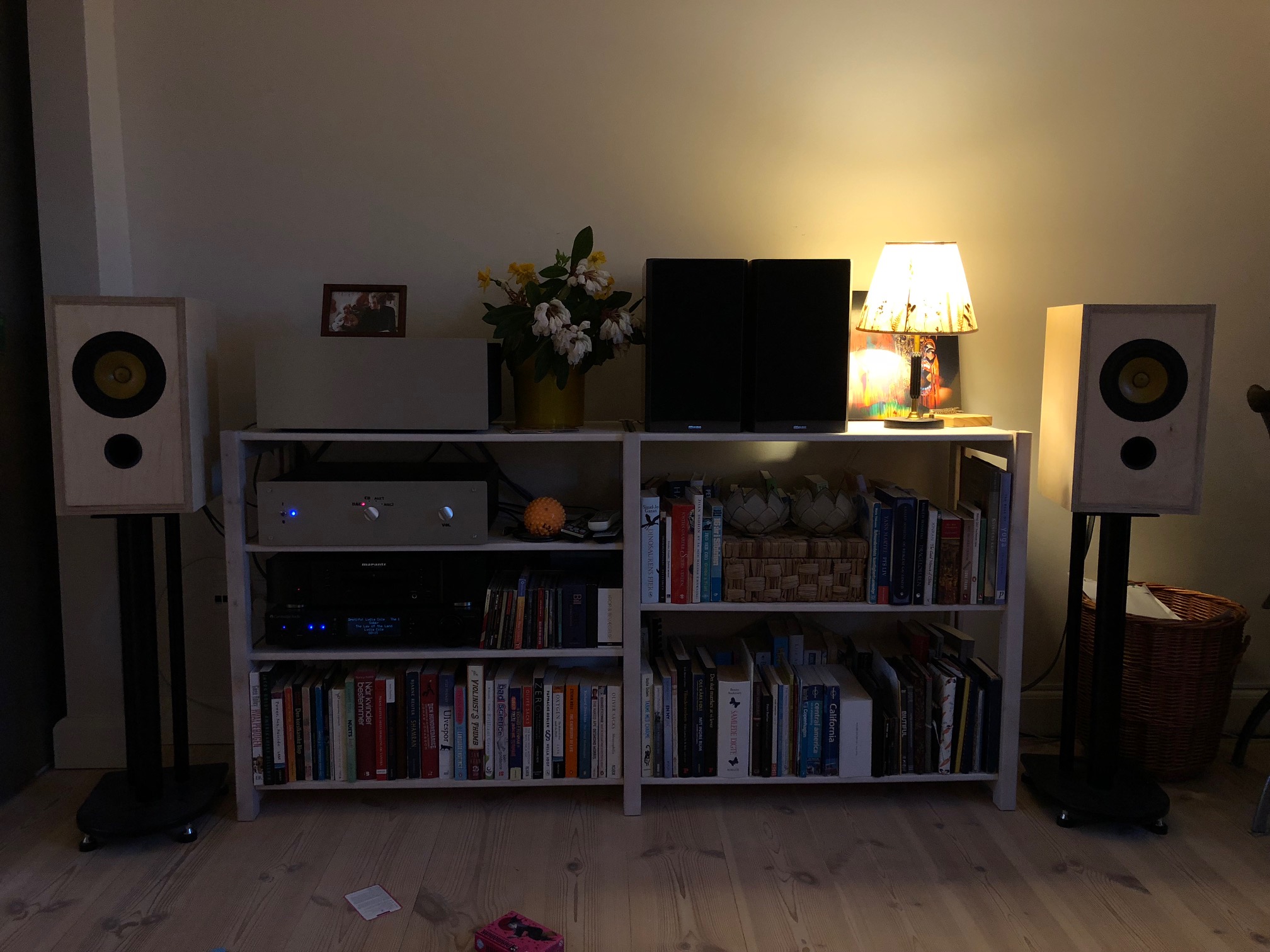
Anyways, thanks again for this design, it was simple enough that a total beginner like me could put them together, and they sound great. Now i'm even more excited to try Pensils 🙂
Silas
Just wanted to say thanks to Scott for this design. I recently built a foamcore MarKen for a pair of enabled 10ps i got from Dave. It was a fun project and a nice sounding box, but compared to my other speakers i felt like they didnt quite fill the room with sound the way i liked. Either not enough bracing or i got something wrong in the tuning when converting the dimensions to fit the foamcore thickness.
Either way, I decided to build these bass reflex standmounts to let me enjoy the drivers while waiting for time to build pensils or frugal horns. I got the panels cut for a reasonable price in some nice 18mm BB ply. First mistake i realized was i didnt get a spare front panel to let me muck around with the router. This is only my second wooden box (the first was a tabaq), but i got away unscathed with a very nice fit by taking it very slowly and measuring 5 times before routing 🙂
Today we had glorious spring weather so i spent the day in the garden gluing up the cabs.
I lined all internal surfaces with 10mm felt and added some monacor mm-4 in the bottom, along the back and top.
They are now in my living room and im listening as i type. They sound glorious with nice meaty bass. The drivers are not fully driven in yet, so i suspect things will only get better. They still need sanding and ill probably stain and laquer them, but i suspect it will take some time before i can get myself to dismantle them for that...
Anyways, thanks again for this design, it was simple enough that a total beginner like me could put them together, and they sound great. Now i'm even more excited to try Pensils 🙂
Silas
Attachments
Last edited:
Quick follow up post and question for these standmounts. I've had some time with them now, and i must say they keep impressing me. I've permanently shelved my Dynaudios. These offer more clarity, better soundstage, they are great at disappearing, and they look nice too (i havent done any finish yet, but i will soon).
They're a pretty astonishing price/performance bargain. Though i didn't go the cheap way, as i got the drivers EnaBled by Dave, they still cost substantially less than €1000 and were manageable to build with very little woodworking experience. If you're looking for a bargain high-performance standmount, these should be considered strongly (a pair of stock drivers are less than €200). Highly recommended!
Now the question: What is the likely hit in terms of efficiency when using such a small box? Any numbers on the efficiency of this design with the A10p? How do they compare to the pensils in efficiency terms?
They're a pretty astonishing price/performance bargain. Though i didn't go the cheap way, as i got the drivers EnaBled by Dave, they still cost substantially less than €1000 and were manageable to build with very little woodworking experience. If you're looking for a bargain high-performance standmount, these should be considered strongly (a pair of stock drivers are less than €200). Highly recommended!
Now the question: What is the likely hit in terms of efficiency when using such a small box? Any numbers on the efficiency of this design with the A10p? How do they compare to the pensils in efficiency terms?
Essentially zero. The overall sensitivity in dB (efficiency is a percentage) to a given signal input is inherent to the driver; back loads only operate over a narrow bandwidth, at the bottom end of the operating region & other than through step-loss &c. do not affect broadband sensitivity per se. Some enclosures are more efficient loads across their operating bandwidth than others; some offer more extension or different alignments, but as noted this is within their relatively small operating window and the driver's sensitivity is what it is. The pensil has a bit more practical extension, a more highly damped impedance load, slightly cleaner midband and a bit more 'slam' through the mid - upper bass. These things are relative of course.
Last edited:
Thanks Scott, that makes sense. I guess the question of extension vs efficiency is more a dilemma for multi-way speakers where crossovers are used to attenuate parts of the frequency band to produce the desired response. This makes sense intuitively, but didn't occur to me before your explanation.
So here is a follow up question (though unrelated) - i was looking through your trove of recently published designs and noticed some differences in the damping of the cabinets. In some you recommend damping the baffle, in others not. What is the best practice for these standmounts? I added felt to the baffle in mine, but cut to leave generous space around the driver cutout.
So here is a follow up question (though unrelated) - i was looking through your trove of recently published designs and noticed some differences in the damping of the cabinets. In some you recommend damping the baffle, in others not. What is the best practice for these standmounts? I added felt to the baffle in mine, but cut to leave generous space around the driver cutout.
Old thread i know.
Should there be any BSC on these designs? I have a pair of 10p drivers on the way and may quickly throw together a ported design before i do my BIB.
I suppose it depends on how close they are to the walls.
Thanks!!
Should there be any BSC on these designs? I have a pair of 10p drivers on the way and may quickly throw together a ported design before i do my BIB.
I suppose it depends on how close they are to the walls.
Thanks!!
It all depends. Room, taste, ancilliary gear all play a role. We have personally found many BSC implementations bring more bass than is natural. Remember that any lift to make the on-axis flat, makes the overall room bass lifted.
dave
dave
would designing the BR response to be flat, then adding in the room gain more or less take care of the baffle step problem... of course assuming stand mount speakers pulled into the room a few feet.
Also assuming the correct baffle width etc.
Probably should stick to said enclosure size... can always do some different port lengths and see how they all sound. 9cm vs 13cm at 5cm diameter.
Also assuming the correct baffle width etc.
Probably should stick to said enclosure size... can always do some different port lengths and see how they all sound. 9cm vs 13cm at 5cm diameter.
Last edited:
Having built a pair of pensil cabs for my enabled 10ps from Dave, i am considering putting these bass reflex cabs to some good use with another set of alpairs. Just wondering, if built using the specifications for the 10p, how big of an issue is fitting the boxes with 10.3's instead?
A10.3 needs to be tuned lower. That means either lengthening the vent of decreasing its cross-section or both (a rolled peice of cardboard inside the existing vent might do to start.
This is the box of which you speak IIRC:
http://wodendesign.com/downloads/simpleReflex-103-10p-plan-100214.pdf
dave
This is the box of which you speak IIRC:
http://wodendesign.com/downloads/simpleReflex-103-10p-plan-100214.pdf
dave
Hey Dave, yes that is the box exactly. If i can somehow modify the existing vent, rather than tearing it out and replacing it that would be preferable. That said, i suppose i could fit a telescopic tube to let me swap drivers in the future without fuss. What would be the optimal cross-section, assuming 120 mm length (10p tuning)? Fiddling with some BR calculators tells me ID = 4.3-4.4 cm should be OK for that length if tuned to 41 Hz, does that sound about right?
Last edited:
Ok quick update, i received the drivers now, got a pair quite cheaply from a recently closed Finnish loudspeaker producer. I have some new bass reflex tubes on the way. Removing the old ones wasnt too difficult, so i've installed the drivers in the boxes temporarily and they are gently playing background music while i wait to finish them 🙂 I'll let you know how they sound once i've gotten past the 300+ h mark 😉
Member
Joined 2009
Paid Member
It just happens that I now have access to a previously loved pair of A10.3's and a bass reflex for portability is a desirable option - this thread looks to be on the Mark 😀
If portability is the goal, then smaller than this gives up little if anything. The optimum Mar-Ken is 13 litre, the A10p 17 litres (same as Scott’s box).
15mm is sufficient for these, for less weight, but you still really need an 18mm baffle (or do veneer (cork or somesuch) on 15mm to flush-mount the driver.
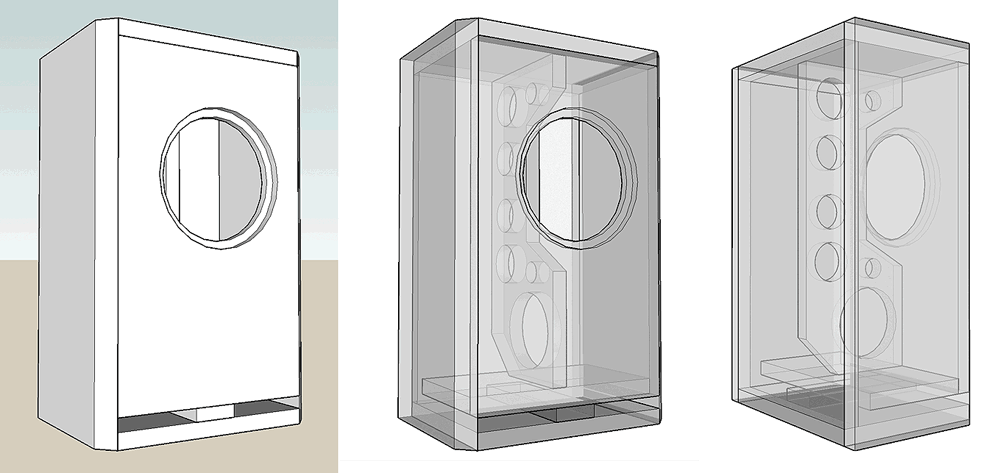
http://p10hifi.net/FAL/downloads/CGR-MarKen103p-plan-040414.pdf
Rigged to be carried face-to-face you’d have a fairly manageable bundle.
dave
15mm is sufficient for these, for less weight, but you still really need an 18mm baffle (or do veneer (cork or somesuch) on 15mm to flush-mount the driver.

http://p10hifi.net/FAL/downloads/CGR-MarKen103p-plan-040414.pdf
Rigged to be carried face-to-face you’d have a fairly manageable bundle.
dave
Member
Joined 2009
Paid Member
that's a good idea, face to face would protect the drivers nicely.
they only have to be reasonably portable - I plan to take them to places in a car and I find that my floor standing speakers are just awkward to move, are heavy and hence risk damage to my car, my back and the speakers themselves.
For the various A10.3 boxes I've seen - I'm curious about the alignments - are they designed to be optimally flat (~0.7) ? I remember the Fonken alignments were sometimes designed for a slower roll-off to gain better f10 performance (<0.7). I'm wondering about going the other direction, allowing for a bit of bass lift to warm up the sound (>0.7). Not sure if others have thought about this ?
they only have to be reasonably portable - I plan to take them to places in a car and I find that my floor standing speakers are just awkward to move, are heavy and hence risk damage to my car, my back and the speakers themselves.
For the various A10.3 boxes I've seen - I'm curious about the alignments - are they designed to be optimally flat (~0.7) ? I remember the Fonken alignments were sometimes designed for a slower roll-off to gain better f10 performance (<0.7). I'm wondering about going the other direction, allowing for a bit of bass lift to warm up the sound (>0.7). Not sure if others have thought about this ?
With the CGR you can move the tuning up by reducing the width of the vent spacer. It should be possible to get tolerances such that one can just be slid in & out.
dave
dave
Unless otherwise stated, when I do a T/S ducted vent box it usually has a damped alignment, degree depending on the specific design and its intended use. Maximally flat or peaking can be problematic, especially if you have quite a narrow tuning at Fb since aside from the question over triggering room modes you can end up with an 'on-off' / 'one-note' style of presentation.
Member
Joined 2009
Paid Member
ah yes, the room. I had forgotten about that.
Also noticed that different plans use different volume boxes. I took a lot at a couple of plans I could find and made a note of the internal volume - although I didn't subtract driver volume it gives some idea that there is quite a bit of variation from 12 to 17 litres.
Also noticed that different plans use different volume boxes. I took a lot at a couple of plans I could find and made a note of the internal volume - although I didn't subtract driver volume it gives some idea that there is quite a bit of variation from 12 to 17 litres.
Attachments
- Home
- Loudspeakers
- Full Range
- Bass reflex standmounts 10.3 / 10P
